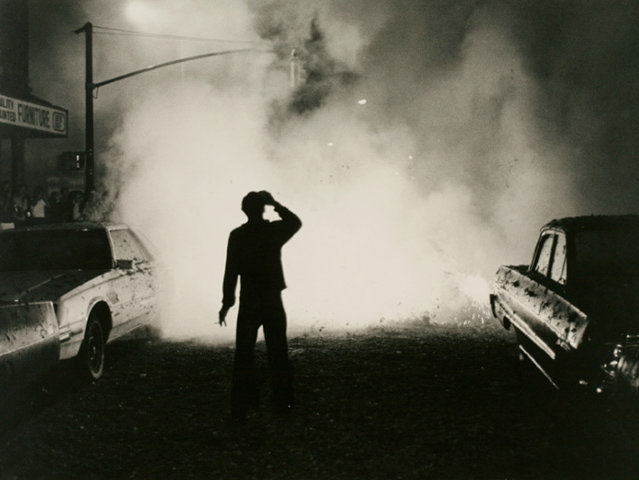In the middle of a dark street, there is a flash of light. It looks like an fire. A figure before it is silhouetted in the night that's been shattered by an explosion. The figure holds his his right hand up to his head.
In another startling image, a boy, backlit, in black and white, holds what looks like a long, improvised weapon, balanced on his hands. We can just barely see his features. The street around him is littered with the detritus of some kind of event.
Are these wartime photographs?
No, they are from American photographer Tom Arndt's photo series, "July 4th, Little Italy, NY." Sixteen of the monochromatic images are on display now in an exhibition at Marquette University's Haggerty Museum, through Aug. 5.
You can see five of the 16 images here.
One of the things that strikes me about these images is that the prove me wrong. Last month, on a visit to New York City, where I was born and raised, I told a friend that New York is so iconic, so unlike other cities in so many ways, that it's nearly impossible to photograph it and render it anonymous.
Arndt's photographs are an exquisite counter to that idea.
Certainly, there are a few clues scattered among the images. In image 01, for example, the street signs are unmistakable New York's.
Beyond those few clues, however, there isn't much. These images celebrate New York, in the sense that they capture the spirit of two downtown neighborhoods – Little Italy and Chinatown – celebrating American independence a way that is common to both Chinese and Italian cultures ... fireworks.
That commonality is especially notable in these once contiguous and now sometimes almost indistinguishable neighborhoods that have jockeyed for space on the tight streets of lower Manhattan for decades. Wandering those streets we are typically struck by cultural differences, not the areas of overlap.
But there is little in these images help us recognize New York lighting off firecrackers and Roman candles. It could be a riot in the banlieue of Paris. Maybe they are images of the clash between G8 protestors and police in Genoa. Perhaps it is a street battle in Afghanistan.
As the exhibition signage notes, "the photographs have an uneasy resemblance to contemporary images of urban warfare and ask the viewer to reconcile the duality of celebrating freedom versus fighting for freedom."
Admission to the Haggerty is free, though donations are welcomed. The Arndt exhibition is located in one of two galleries on the upper level.
Running concurrently on the lower level, also through Aug. 5, is "Selections from the Mary and Michael Tatalovich Collection, which includes works by Richard Serra, Ellsworth Kelly, Chuck Close, Jim Dine and Robert Rauschenberg, among others.
Born in Brooklyn, N.Y., where he lived until he was 17, Bobby received his BA-Mass Communications from UWM in 1989 and has lived in Walker's Point, Bay View, Enderis Park, South Milwaukee and on the East Side.
He has published three non-fiction books in Italy – including one about an event in Milwaukee history, which was published in the U.S. in autumn 2010. Four more books, all about Milwaukee, have been published by The History Press.
With his most recent band, The Yell Leaders, Bobby released four LPs and had a songs featured in episodes of TV's "Party of Five" and "Dawson's Creek," and films in Japan, South America and the U.S. The Yell Leaders were named the best unsigned band in their region by VH-1 as part of its Rock Across America 1998 Tour. Most recently, the band contributed tracks to a UK vinyl/CD tribute to the Redskins and collaborated on a track with Italian novelist Enrico Remmert.
He's produced three installments of the "OMCD" series of local music compilations for OnMilwaukee.com and in 2007 produced a CD of Italian music and poetry.
In 2005, he was awarded the City of Asti's (Italy) Journalism Prize for his work focusing on that area. He has also won awards from the Milwaukee Press Club.
He has be heard on 88Nine Radio Milwaukee talking about his "Urban Spelunking" series of stories, in that station's most popular podcast.







